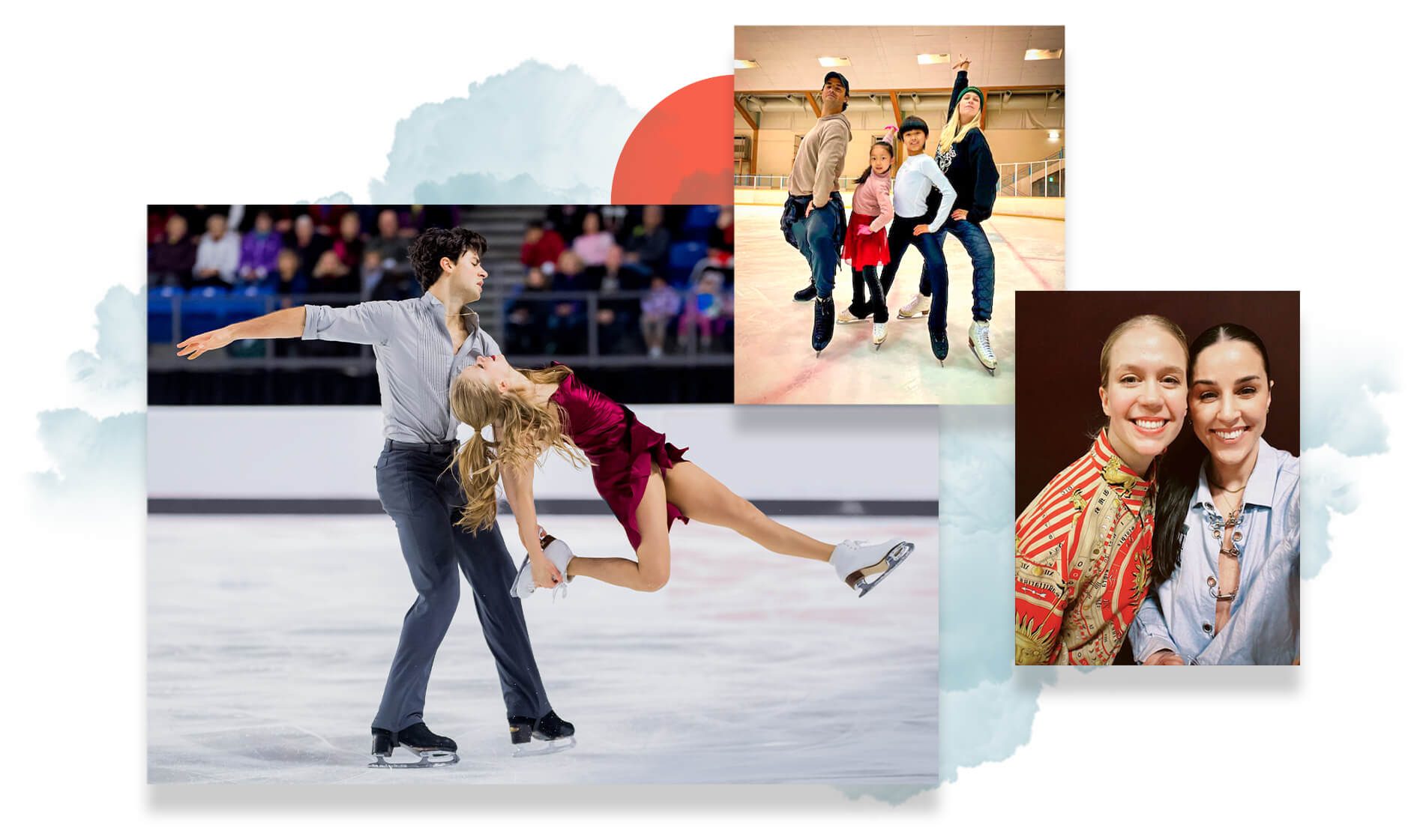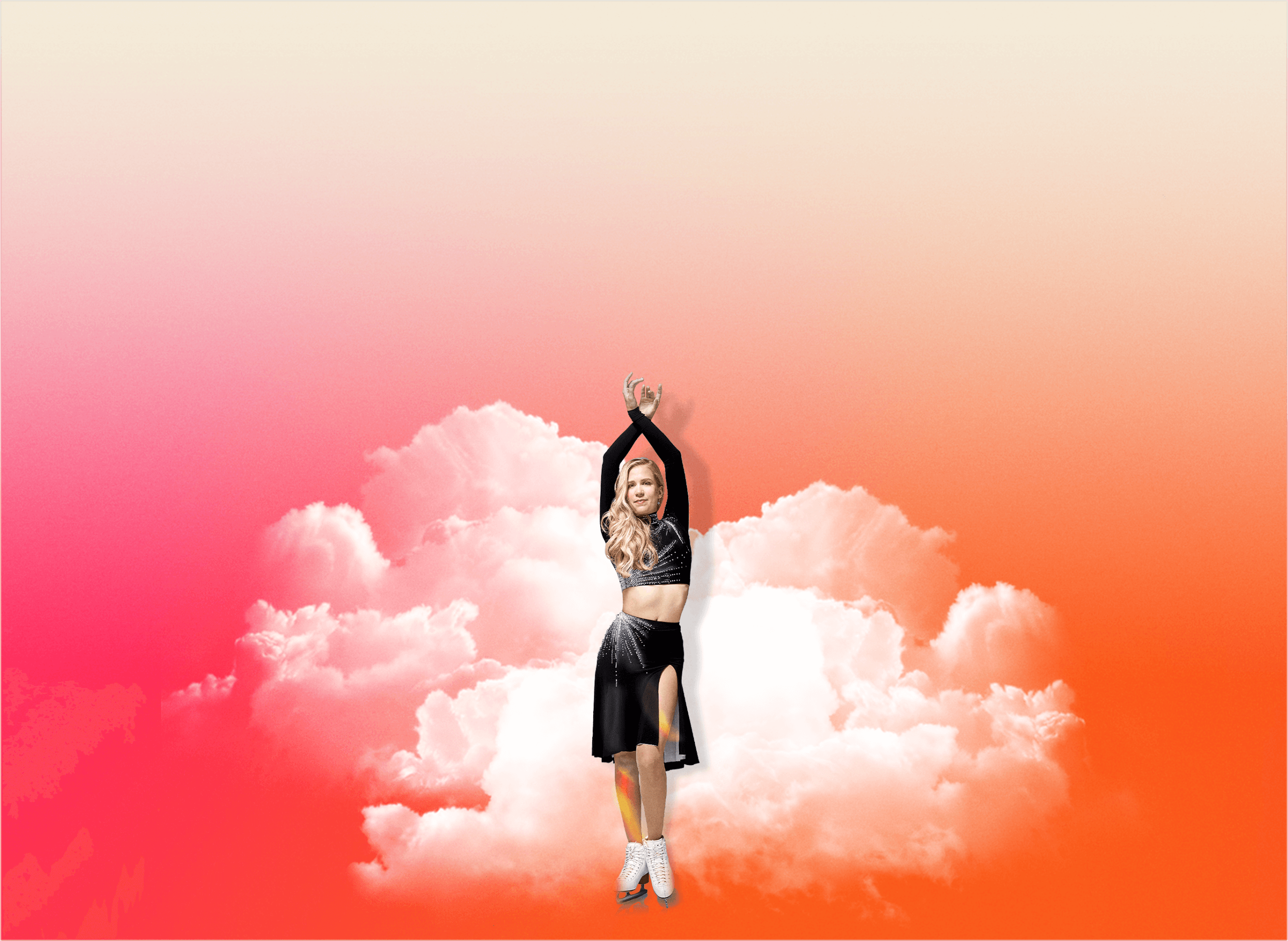How does a woman in a sport that celebrates conventional femininity adapt when she comes out? This being ice skating, that is indeed a slippery prospect. But just like learning a new skating maneuver, it can be an exhilarating work in progress.
Recently, Kaitlyn Weaver, a two-time Olympian in the sport of ice dancing, posted an Instastory in which she was going through skating costumes from her competitive days. Some are iconic to skating fans, especially a dark red dress with a strap that intentionally slips down—don’t worry, the dress was secured—and others suggest the role of a leading lady that Weaver long played with her skating partner of 18 years, Andrew Poje.
Five years after retiring from competitive skating and three years after Weaver announced to the world that she is queer, she and Poje still perform in shows and tours. While the speculation of whether they are a romantic couple off the ice has disappeared, they still share a close friendship and on-ice chemistry. That doesn’t mean there aren’t changes large and small in how Weaver presents herself to the world. Even more important, there are changes in how she views skating and her goals as a choreographer and artistic force.
“First is how we talk about choreography and skating, even just the language that we use,” Weaver said. “If I’m working with a young woman, I’m not asking her what feels pretty. I’m asking what makes her feel good, what makes her feel strong, what makes her feel comfortable.”
While she didn’t envision herself becoming a choreographer, her encyclopedic knowledge of skating movement has fueled her creativity and love of the sport, along with the guiding principle that a program takes the viewer on a journey.
“That plus my activism, my queerness, and the effort to be an educated person in the skating community about what gender roles are, what they mean, and how we can support young women in the sport, trans people in the sport, queer people in the sport,” she said. “Now, there’s this opportunity to put these things together in a unique way.
“I have my personal identity that has really merged with who I am on the ice, which was not for free—it took a lot of work to get to that point,” she added. “Now, I’m able to choreograph and really use my whole voice and my skating background and who I feel like I’ve grown into. It’s almost like it’s all been leading up to this.”
As for those costumes, unpacking boxes proved thought-provoking. While the costumes may still fit physically, they no longer fit her as a person.
“For me, the programs are such a page out of that chapter of my life,” she said. “Everything I was, was wrapped up into those characters on the ice. … When I’m looking back at those things, I’m almost stepping into a time capsule. Yes, it’s just a costume, or yes, it’s just a character, but it was me. I look back with compassion.”
In 2006, Weaver, who was born in Texas and moved to Connecticut for training as a teenager, began representing Canada in international competition. She took on dual citizenship, becoming a Canadian citizen in 2009, and won three Canadian championships and three World Championship medals with Poje. After retiring from competitive skating in 2019, she moved to New York City.
During a recent round of closet purging, she opened a box she hadn’t touched since moving into her current apartment in 2020. The box was packed as if she’d just retired from competition yesterday.
“I was going through it and it was so visceral,” she described. “I had so many things, so many items in my possession that I felt I needed to get by. It was all of these elements of feminine beauty. Products and makeup and hair things and sparkles and eyelashes. It was like a drag kit.
“I used to think this is what it took…all of this exterior stuff,” she continued. “It was deeply emotional for me and equally as emotional to let it go. It’s not to say I veer away from femininity. I love being girlie, stereotypically, but it’s a balance and I choose that. I don’t feel I need to be that all the time to feel heard or seen.”
As for the costumes, she considered what would happen if a show producer requested she and Poje reprise a particular routine from their past repertoire. There was definitely angst thinking about it, but she came to the realization that it’s OK to politely decline something inauthentic.
Although she is willing to recreate some of the programs with Poje, she envisions more androgynous costumes and interpretations. Upon reflection, Weaver said while the world may have seen a romantic couple, she now sees certain programs that make space for her queerness. Their most famous free dance—that one in the dark red dress with the sliding strap—was about love lost and the realization that a relationship isn’t going to work. A free dance about two statues coming to life was about honoring and savoring every moment. A fiery Argentine tango was about strong feminine power.
“No wonder I felt I could really perform those because they allowed me to be who I was,” Weaver said. “Not all of our programs did that. … I’m happy there were glimpses in there that really were freeing and liberating to me in the moment.”

Photo By: Skate Canada
Changes in style, whether personal or culturally driven, aren’t really discussed in skating. She loves the idea of recreating the Argentine tango with her and Poje wearing identical costumes.
“Andrew and I are still creating,” Weaver said. “I feel like so many of these stories are universal, and maybe we’ll do it to a different piece of music or different type of character. The universal stories are the things that matter most.”
Last year, Weaver got a plum assignment as choreographer and director for the Stars on Ice Holiday Tour, which toured Canada and one U.S. city in December.
“I had done a women’s number for the tour a year prior. The feel was the women supporting each other, not just being on display,” Weaver said.
A holiday show doesn’t immediately come to mind when thinking of queer expression. Still, she grounded her choreography in universal truths about the magic of the holidays with the joy of togetherness and community central. Within that, she was able to test out ideas.
“My girlfriend [Sydney] kept saying, ‘You can’t put all of your ideas into one show,’” she said. “I wanted to represent all of these different things that I think we need to be talking about. It was kind of like the scarcity mindset of ‘if this never happens again, make sure I do this, this, and this,’ but she told me to go with the themes that I love and leave the rest for next year. It was a huge success, and I think the cast was really paramount. They were championing me and gung ho about it. There were no ‘oh shit’ moments.”
She has continued her involvement with Canadian skating, taking delight in the decision of Skate Canada to redefine the definition of “team,” allowing same-sex couples to compete in pairs and ice dance. Last fall, two young ice dance teams in which both partners are female debuted at the Skate Canada Challenge in the pre-novice division.
“It’s like, ‘Ah yes, finally,’” said Weaver. “It’s just so cool. The kids apparently are all for it. [Their coaches, Megan Wing and Aaron Lowe] said, ‘We don’t make it a big deal.’ They treat them just the same as everybody else. If they’re going to train, they’re going to go all in, and that’s how they teach them. I think that’s awesome.”
Change is slow in skating, but Weaver keeps having conversations that can move the needle. She is the appointed skater on the International Skating Union (ISU) ice dance technical committee. The six members of the committee make the rules for ice dance. “We’re challenging what the norm is,” she said. “We have to continue to have the conversation. We have to continue to push.”
Weaver is not the only openly out woman in the sport. U.S. ice dancer Karina Manta came out as queer in 2018, two-time U.S. Women’s Champion Gracie Gold described herself as bisexual in her recent memoir, and the current U.S. Women’s Champion Amber Glenn became the first openly queer woman to win a U.S. title. In her moment of victory at the U.S. Figure Skating Championships in January, Glenn gleefully held up a Progress Pride flag.
“We can honor where we’ve been, but we can also make space for where we need to go,” Weaver said.
Living in New York City provides an influx of art and music information, constantly stimulating and inspiring Weaver. A previous relationship with a dance choreographer was essential in exploring how she could turn her queer identity into artistic expression.
“Creativity comes from the soul,” she said. “It’s the beautiful meeting of the mind and the heart and opening yourself up to other people, especially if you’re creating with someone, which we’re doing. I don’t think you can do that unless you really know yourself. I don’t think you can do that unless you’re really accepting of where you are, which can be painful.
“If I didn’t do the work to get to where I’m at in my queerness and in my self-acceptance, there’s not a doubt in my mind I wouldn’t have this voice as a creator,” she said. “When you’re too busy pretending and worrying about what everybody else is thinking, you can’t make art.”
During the coronavirus pandemic, she developed Open Ice Live, a fundraiser that raised $60,000 for the UN Foundation’s COVID-19 Solidarity Response Fund. Jordan Cowan, a videographer, helped her figure out how to put on a four-hour livestream with 60 skaters in different corners of the world engaged in conversation. Its improbable success empowered Weaver to be a force for change. She registered Open Ice as a nonprofit and in 2021 made a documentary film with four of skating’s visionaries discussing charitable causes of importance to them.
In addition to performing and choreographing, she has also done television commentary in the U.S. and Canada. Through it all, Weaver has become emboldened to challenge skating conventions in terms of movement and presentation.
“There is so much space in skating for redefining what it can look like and who belongs,” she said. “We’re taught from such a young age that we have to move, speak and personify a certain role. There’s so much space for more than that. I want the highest level to be a representation of what we can do. That can have power and trickle down hopefully to people coming into the sport that don’t necessarily see themselves there.”
